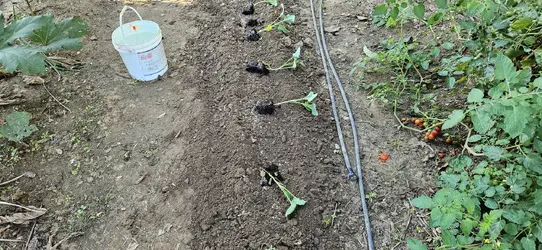Trying something new this season. Not new to fermenting -- we make our own sauerkraut, fermented pickles, fermented radishes, etc. But fermented tomato juice is a new one for me. We planted a lot of tomatoes and normally we'd can the excess, but when the day came to break out the canner I was feeling lazy and tired. So what would be an easier option? Fermentation!
Did some research on the internet and found enough conflicting recipes and instructions to keep me reading till I die. So I came up with my best assessment knowing what's basically required. I start with a 3 liter jar -- wash and chop the tomatoes and load them in along with a dozen fresh basil leaves, one medium garlic clove cut in half, and two teaspoons of pickling salt. Crush the tomatoes loosely and close the jar. Fermentation will begin soon.
Note the room I left at the top of the jar -- at least that much if you don't want a mess in a day or two when you open the jar to stir it. The tomatoes will rise in the jar and need to be stirred down once or twice a day. Fermentation will take approx. 6-8 days. Watch for a thin film of yeast (white) to form on top of the mixture (just stir it in) and you're a day or two away from the next step.
When the fermentation slows the hard job is to push it all through a sieve to separate the seeds and skins from the juice. I've been getting two liters of juice per batch with a cup left over.
BIG DEAL: If it's going to keep additional salt is required. The salt is essential to preserve the bottled juice. Deciding how much salt was my big struggle with this and where I found the internet varying wildly. I decided on .7% salt solution which is low. This is the catch with all fermented foods; they're salty.
Once bottled (pickling salt added) pour in a little olive oil. Place the cap on the bottle but don't seal. The salt may or may not stop the fermentation. Normally it has for me but one batch didn't and I had to wait two days before I was confident I could clamp down the lid. So far I've bottled 10 liters with 6 more in process. The jar below was just stirred and is finishing day 3. Interesting how the juice settles in the bottle after a couple days.
So far I've used 1 & 1/2 liters with the bottle going in the frig once opened. It's too salty to just drink straight but it makes a great additive in cooking. So far I'm cautiously claiming success.
View attachment 268518


 It's amazing that she survived the transplant.
It's amazing that she survived the transplant.











![[No title]](/data/xfmg/thumbnail/37/37110-1d5d98524f9f6a8623703161610ef439.jpg?1734169830)